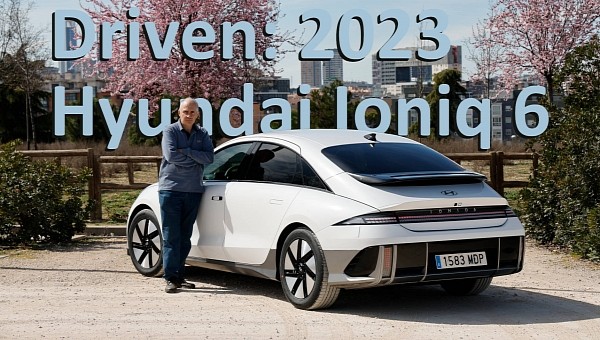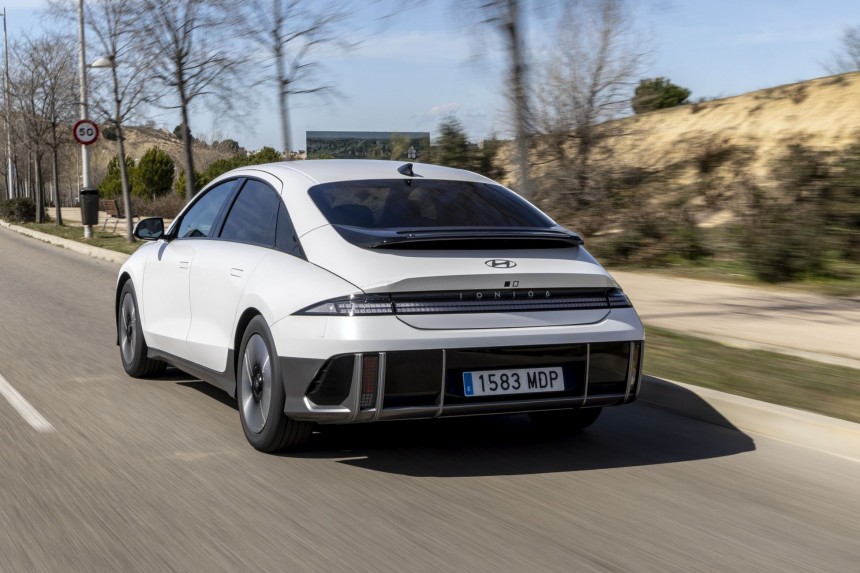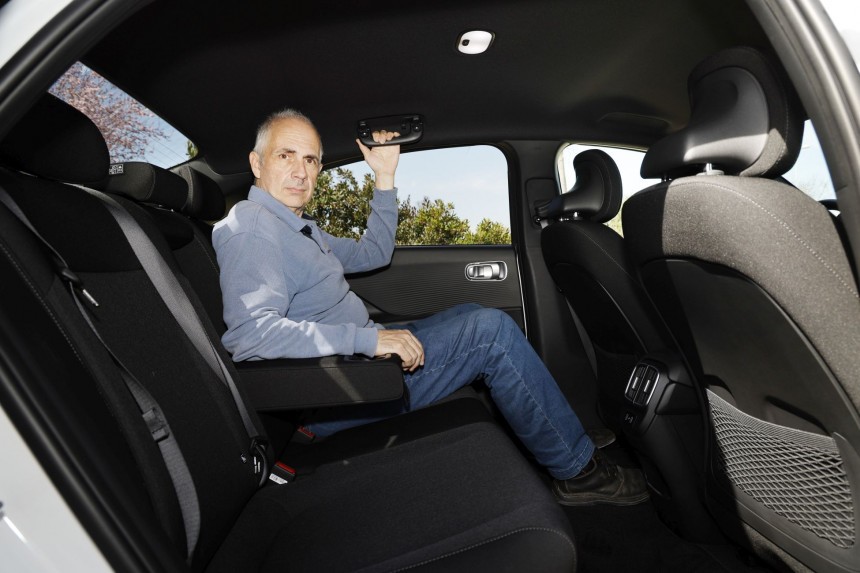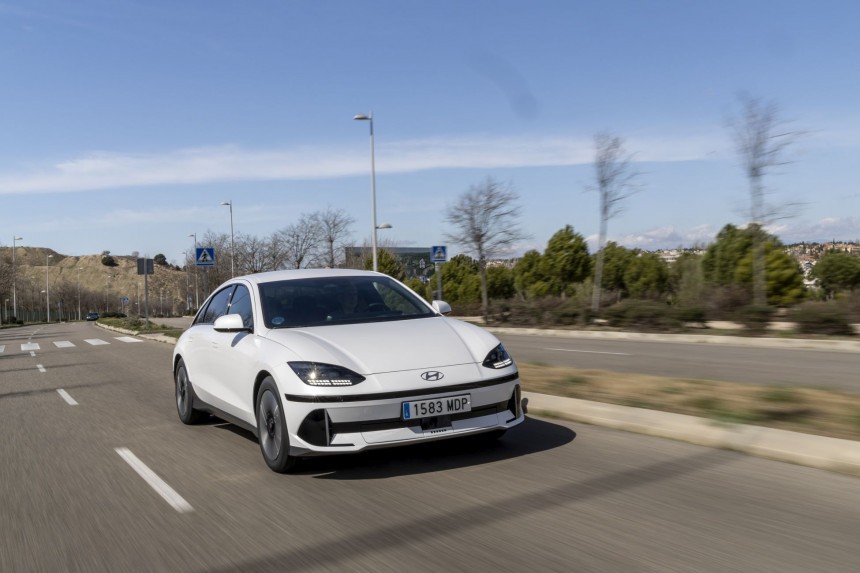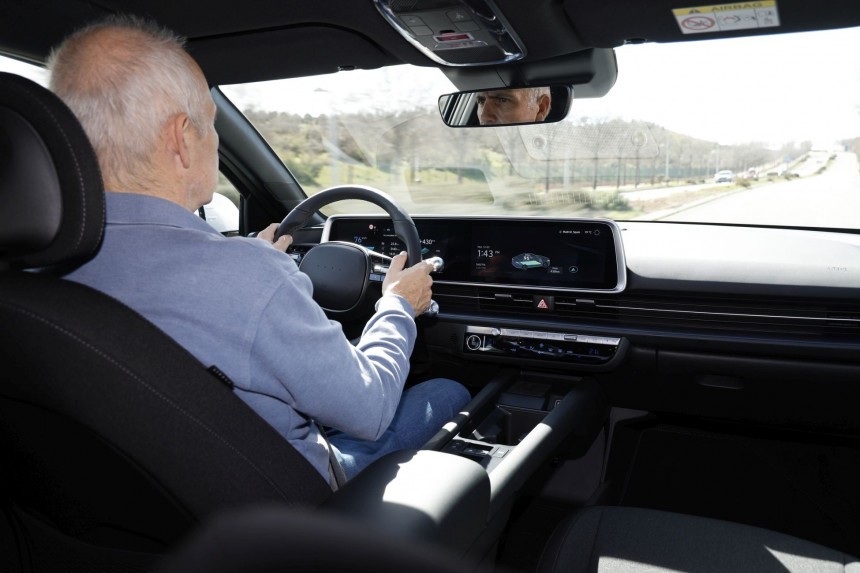The E-GMP platform is used by three Hyundai electric models: the 2021 Ioniq 5 CUV (Crossover Utility Vehicle), based on the 45 EV Concept, the Ioniq 6 sedan, based on the Prophecy concept, and the future Ioniq 7, a three-row seat model based on the SEVEN concept.
Design evaluation
The design of the Ioniq 6 has sparked greater controversy than the BMW models from the Bangle era. Some say it's ugly, while others claim that it copies the Porsche 911, Taycan, or Panamera at the rear, or that it resembles a Tesla or Lamborghini from the front. However, Hyundai didn't copy anyone, but rather wanted to create a very aerodynamic sedan. And if we talk about a source of inspiration, Hyundai said that it was the streamliner era of the '30s. The aerodynamics époque from the early 1930s to World War II served as an example for Hyundai.Returning to people's opinions on social media, indeed, the large rear spoiler with red LEDs that light up when you press the brake pedal is very similar to the "duck tail" of the 1975 Porsche 911 Turbo 930. But its purpose is to limit the turbulence that occurs at the rear and ensure a smooth air flow. Moreover, almost all design elements have a functional aerodynamic role: the active flaps at the front, air curtains at the front wheels, and exterior door handles integrated into the bodywork.
Another major issue regarding aerodynamics arises regarding the wheels; Hyundai has solved this by using closed alloy wheels (18-inch on the test model, 20-inch optional) and completely minimizing the gap between the wheel arches and the wheels.
Last but not least, the floor is completely covered underneath, and – as an option – cameras are provided instead of rearview mirrors. This made achieving a Cd of 0.21 possible, just 0.01 below the much more expensive Mercedes EQS, which holds the aerodynamics record.
Interior assessment
With simple, curved lines and a low silhouette, the Hyundai Ioniq 6 looks quite compact, but it's actually a large sedan with a length of 16 feet (4.86 meters) and an ample wheelbase of 9.67 feet (2.95 meters). Therefore, it's only 3.93 inches (10 cm) shorter than the Porsche Taycan, but the wheelbase is 1.96 inches (5 cm) longer.Thus, there’s no surprise that the room in the back is huge. Passengers can stretch their legs without touching the backrests of the front seats with their knees. And if they sit normally, there are still about 11.81 inches (30 cm) of kneeroom.
The feeling of roominess in the back of the car resembles that of the Mercedes S-Class. Due to placing the battery under the floor, this is completely flat; Hyundai didn't have to resort to any tricks, like in the case of the Porsche Taycan, where the battery has a clearance near the rear passenger's feet. Thus, the third rear passenger can sit almost as comfortably.
The driver is also highly advantaged, as to enjoy a low and very comfortable driving position. However, the seats in the standard version do not offer great lateral support. The Relaxation Comfort seats can be ordered as an option; they are 30% thinner and allow for a greater tilt, almost turning into a bed when, for example, you are waiting at a charging station.
Due to the very rounded rear, the trunk’s volume is affected, with only 14.47 cu-ft (410 liters), but you can split the rear bench. However, there is a cable compartment under the trunk's floor that can be used to store additional luggage. This is because the Ioniq 6 comes with a 1.58-cu-ft (45-liter) frunk for single-motor versions (0.51-cu-ft/14.5-liter for versions with a second motor on the front axle).
The dashboard layout draws inspiration from the Hyundai Ioniq 5, mixing a classic design with a minimalist hi-tech look: two 12.3-inch displays and an HVAC panel with touch controls placed below the infotainment system screen.
The gear shifter – reminiscent of the VW ID.3's – is hidden in the lower right part of the steering wheel. Kind of curiously, the window controls are placed on the center tunnel, and the interior hosts many hard, dark-hued plastics. Moreover, there aren't many options when it comes to interior colors: Dark Gray with Light Gray or Black Monotone are the only ones available. Therefore, the interior ambiance is quite sober and dull.
Hyundai prioritized the use of as many recyclable materials as possible. Thus, the fabric upholstery and headliner lining are made of recycled PET bottles, the bio paint on the door cards is derived from vegetable oils, and for the first time in the Ioniq range, the floor mats use materials recycled from fishing nets recovered from the world's oceans.
The interior atmosphere is brightened up by the ambient lighting with 64 colors and six themes, as well as the four LEDs that communicate with you and light up when you get in, use the voice command, or choose the Eco driving mode. A laser color head-up display provides various information, including navigation system data.
The infotainment system supports both Apple CarPlay and Android Auto and uses Bluelink services that offer over-the-air updates for maps and car software systems, cloud navigation, the ability to lock or unlock the car remotely or to program battery preconditioning, parking location, and more. Voice command allows control of the Bose sound system, as well as commands for steering wheel heating, seat cooling/heating, and other functions.
Driving take
Ioniq 6 is available in three versions: with a small 53 kWh battery combined with a 151 ps (149 hp) motor on the rear axle (WLTP range of 267 miles or 429 km), with a large 77.4 kWh battery combined with a 228 ps (225 hp) motor on the rear axle (WLTP range of 382 miles or 614 km), or with two motors totaling 325 ps (320 hp) and electric all-wheel drive (WLTP range of 362 miles or 583 km). The versions with the small battery have only 18-inch wheels, while the other two can be ordered with 20-inch wheels that, however, affect the range, which is shortened by 43 and 40 miles (69 and 64 km), respectively.We tested the version with the large battery, of 77.4 kWh, combined with the more powerful rear motor that provides 168 kW (228 ps/225 hp) and 350 Nm (258 lb-ft) of torque. On the left bottom of the steering wheel, there is a rotary switch like in Porsche from which you can select the Eco, Normal, and Sport driving modes. These vary the steering response, the sensitivity of the accelerator pedal, and the power of the motor, but do not modify the suspension stiffness.
Hyundai doesn't disclose how much power is reduced in Eco mode, but it is obvious, while driving, that the engine loses some tens of horsepower when that setting is selected. In Sport mode, the steering requires a slightly greater force to operate, and the accelerator pedal reacts more spontaneously to pressure.
With a decent weight for this class, of 4,376 lb (1,985 kg), the Ioniq 6 feels quite light and drives pleasantly, and in Sport mode, the 228 ps (225 hp) electric motor performs honorably. The car accelerates vigorously up to 87-93 mph (140-150 kph), yet without being truly sporty. However, handling is safe, neutral, the rear axle has very good grip, and the steering provides decent feedback.There are no different levels of regenerative braking, only a One Pedal mode that is activated from the paddles located behind the steering wheel. It doesn't brake as intensely as, for example, the Nissan Leaf, but allows for brakeless driving if you anticipate the traffic a little bit. It should also be noted that the brake pedal is linear, as there is no noticeable difference between the transition from the first part of the pedal stroke, when regenerative braking is active, and the second part, when hydraulic braking takes over. In this regard, Hyundai has handled the situation more elegantly than the Mercedes EQS, for example.
Many pages from the press release focus on the assistance systems. Hyundai offers the maximum in this regard, but these systems are a little too cautious. The parking assistant beeps even when the car is 19.7 in (50 cm) away from a lateral obstacle. On the other hand, the lane assistant with active steering correction works better than in some rival models, as it keeps the car in the center of the lane and the direction corrections are soft.
For the first time on a European model, the Ioniq 6 has Matrix LED headlights, and they boast no less than 700 parameterized pixels, used for daytime running lights, taillights, and for the large rear spoiler, as well.
Even though it lacks an adaptive suspension, the five-arm multilink rear suspension provides great ride comfort when combined with the standard 18-inch wheels and is very quiet. Only when passing over sewages or potholes can one feel that the suspension is set slightly stiffer. The overall noise level is low – almost nothing can be heard since the wind noise, too, is lower than in other rival models. The Ioniq 6 cuts through the air like a spaceship, while the driver only hears an artificial sound with four varying intensities in accordance with the driving style.
In faster corners, the Ioniq 6 has moderate roll; but it performs best on long journeys on the highway, where the long wheelbase contributes to increasing comfort.
The test route was relatively short, at 93 miles (150 km), and alternated highway sections with passing through a few small Spanish towns and a short mountain course. We used all driving modes, selecting the Sport mode on the highway and Eco mode in cities. The real average fuel consumption was impressive: only 147.5 mpge (14.2 kWh/100 km). In the end, we still had a range of 208.15 miles (335 km).
Considering the 77.4 kWh battery capacity, this consumption leads to an equivalent range of 310.68 miles or 500 km (381.5 miles or 614 km official WLTP range). The exceptional aerodynamics played an important role, especially on the highway, when we reached speeds of 87-93.2 mph (140-150 kph). A range of 310.6 miles (500 km) provides extra comfort on long journeys, so you don't have to stop too often for charging.
Ioniq 6 uses an 800V platform which is also compatible with 400V networks. In addition, the high-voltage system allows for fast charging at DC stations of up to 232 kW. Thus, at a high-power DC station, the battery only needs 18 minutes to charge from 10 to 80%. Moreover, in Europe, the Ioniq 6 owners can enjoy a free 1-year subscription to the IONITY network.
Like the Ioniq 5, the Ioniq 6 is one of the few cars that offer bidirectional charging, the so-called V2L (vehicle to load) system. Thus, the car can provide up to 3.6 kW, enough for you to power an LCD TV and a refrigerator or air conditioning and some light bulbs for 24 hours solely using the battery energy. Also, there is a 220V socket at the bottom of the rear seats where you can charge a laptop or other device.
The Hyundai Ioniq 6 has a starting price of 43,900 euros in Europe, same as the Ioniq 5. For an additional 8,487 euros, you get the larger battery and more powerful motor, and 14,453 euros over the base version provide you with the top model with two motors. In this regard, any comment would be out of place because no other manufacturer offers such a spacious sedan with a similarly long range at this price. The generous interior room, excellent ergonomics, and practical aspects of bidirectional charging are other important advantages.
Pros:
- Very good range
- Huge interior room
- Impressive package of assistance systems
- Unbeatable price
- Bidirectional charging
Cons:
- Dull interior ambiance
- Controversial design
- Some cheap plastics
- Relatively small trunk
- Window controls on the center tunnel
